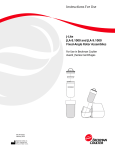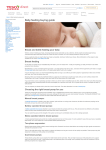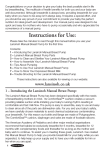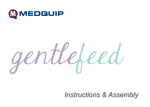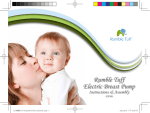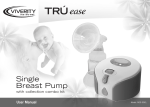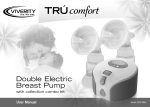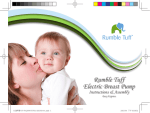Download Manual Breast Pump General Notes All parts can be sterilised. 1
Transcript
Manual Breast Pump General Notes All parts can be sterilised. 1. Disassemble and wash all 8 pump parts (including stand/funnel cover ) 2. Sterilise all pump parts After sterilisation, completely air dry before assembly and next use. Handle the milk valve with care, so the tip is not damaged. Do not use a stiff brush. Do not use polishing powder. Materials POLYPROPYLENE - Pump Body, Handle, Stem, Stand/Funnel Cover, Bottle, Cap, Hood, Wide Neck Bottle Adaptor SILICONE RUBBER - Milk Valve, Teat TPE (SEPS) - Sealing Disc, Handle Grip Sterilisation Methods – Microwave, Steam, Boiling, Chemical, Autoclave (Parts which CANNOT be autoclaved - Pump Body, Handle, Stem, Stand/Funnel Cover, Bottle, Cap, Hood, Wide Neck Bottle Adaptor) Do not sterilise using dry heat, or ultraviolet (UV) rays. Silent Electric Breast Pump General Notes MOTOR UNIT Wipe the motor unit with a dry cloth. Do not wash or clean the motor unit with a damp cloth. The joint cup, lid and silicone tube do not need daily cleaning; they do not come into direct contact with milk. Normal washing when required is sufficient OTHER PARTS Clean and sterilise after every use Disassemble, wash and sterilise the 7 pump parts -Advanced Sealing Air Cushion, Inner Cup, Joint Cup, Pump Body, Milk Valve, Bottle, Stand/Funnel Cover After sterilisation, completely air dry before assembly and next use. Handle the milk valve with care, so the tip is not damaged. Do not use a stiff brush. Do not use polishing powder. Materials POLYPEOPYLENE - Pump Body, Lid, Joint Cup, Stand/Funnel Cover, Bottle, Cap, Hood, Wide Neck Bottle Adaptor SILICONE RUBBER - Advanced Sealing Air Cushion, Inner Cup, Tube, Milk Valve, Teat TPE (SEPS) - Sealing Disc Sterilisation Methods – Microwave, Steam, Boiling, Chemical, Autoclave (Parts which CANNOT be autoclaved - Motor, Pump Body, Lid, Joint Cup, Stand/Funnel Cover, Bottle, Cap, Hood, Wide Neck Bottle Adaptor) Do not sterilise using dry heat, ultraviolet (UV) rays or a dishwashing/ drying machine. Doing so can damage the pump parts. Portable Electric Breast Pump General Notes Never wash electrical parts in water. Avoid wiping electrical parts with a damp cloth. Take great care if using the Breast Pump near water. After sterilisation, completely air dry before assembly and next use. Handle the milk valve with care, so the tip is not damaged. Do not use a stiff brush. Do not use polishing powder. Materials POLYPROPYLENE - ABS Pump Body, Wide Neck Cap, Wide Neck Hood, Wide Neck PP Bottle, Breastmilk Storage Cap SILICONE RUBBER - Advanced Sealing Air Cushion, Milk Valve, Inner Cup, Teat Sterilisation Methods – Microwave, Steam, Boiling, Chemical, Autoclave Parts which CANNOT be autoclaved - ABS Pump Body, Wide Neck Cap, Wide Neck Hood, Wide Neck PP Bottle, Breastmilk Storage Cap Do not sterilise using dry heat, ultraviolet (UV) rays or a dishwashing/ drying machine. Doing so can damage the pump parts. Peristaltic Teats General Notes The teat opening and ventilation hole can become clogged. Clogging can lead to teat collapse. Keep the teat opening and ventilation hole clear. The tip of the teat is very delicate. When using a teat brush to clean it, gently press the tip with the tip of the finger while washing. Inspect before each use and pull the teat in all directions. The teats may be worn by biting. Special attention is needed for teething children. Throw away at the first signs of damage or weakness. Do not leave a teat in direct sunlight or heat, or leave in disinfectant/sterilising solution for longer than recommended, as this may weaken the teat. When not in use, keep in a dry, covered container. Materials SILICONE RUBBER Sterilisation Methods – Microwave, Steam, Boiling, Chemical, Autoclave Heat Resistance: 120 degrees C PPSU Bottles Materials POLYPHENYLSULFONE (PPSU) - Bottle POLYPROPYLENE -Cap, Hood, Teat Pin SILICONE RUBBER – Teat Sterilisation Methods – Microwave, Steam, Boiling, Chemical, Autoclave Heat Resistance: BOTTLE 180 degrees C Parts which CANNOT be autoclaved TEAT, CAP, HOOD, TEAT PIN 120 degrees C PP Bottles Materials POLYPROPYLENE (PP) Bottle, Cap, Hood, Teat Pin SILICONE RUBBER Teat Sterilisation Methods – Microwave, Steam, Boiling, Chemical, Autoclave Parts which CANNOT be autoclaved Heat Resistance: BOTTLE 110 degrees C TEAT, CAP, HOOD, TEAT PIN 120 degrees C Glass Bottles General Notes The glass is breakable if dropped, or subject to an impact. Handle with care. Materials GLASS POLYPROPYLENE SILICONE RUBBER POLYCARBONATE Bottle Cap Teat Hood Sterilisation Methods – Microwave, Steam, Boiling, Chemical, Autoclave Heat Resistance: BOTTLE 600 degrees C Parts which CANNOT be autoclaved TEAT, CAP, HOOD, TEAT PIN (Max Temperature 120 degrees C)



